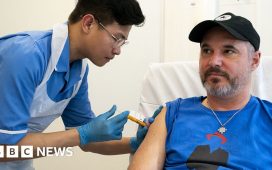Last week reports came out of China of thousands of children coming down with pneumonia. While children are more likely to become ill during the winter, the number of cases in Beijing caused concern.
Over a week after the alarm was raised about the skyrocketing rates of illness in China scientists are coming to terms with the viruses that are causing the outbreak, but they don’t currently know why.
Furthermore, the steep rise in cases of pneumonia is not limited to children. In Europe, cases have started to surge as the virus has spread.
As a result, there are now concerns that the virus could spread to the UK and cause cases to spike, putting more pressure on the NHS at the time of year when it is under greater stress.
One of the main things that is now known about the outbreak in China is that the pathogens are not unusual or novel, this means that they are not new.
In a statement released about the outbreak, the World Health Organisation (WHO) said: “Chinese authorities advised that there has been no detection of any unusual or novel pathogens or unusual clinical presentations, including in Beijing and Liaoning.
“They further stated that the rise in respiratory illness has not resulted in patient loads exceeding hospital capacities. The Chinese authorities advised that, since mid-October, enhanced outpatient and inpatient surveillance has been implemented for respiratory illnesses covering a broad spectrum of viruses and bacteria.”
They also said that China “has systems in place to capture information on trends in influenza, influenza-like illness” and that the WHO “is closely monitoring the situation and is in close contact with national authorities in China”.
As to the level of risk caused by this outbreak, the WHO said: “In the current outbreak of respiratory illness, the reported symptoms are common to several respiratory diseases and, as of now, at the present time, Chinese surveillance and hospital systems report that the clinical manifestations are caused by known pathogens in circulation.”
“According to surveillance data reported to WHO’s FluNet and published by the National Influenza Centre in China, ILI (Influenza Like Illnesses) was above usual levels for this time of year and increasing in the northern provinces.”
The WHO said it did not recommend any specific measures for people travelling to China and advised against the “application of any travel or trade restrictions based on the current information”.
Just days after this statement was released on November 23 the New York Post reported that pneumonia cases had unexpectedly surged in the Netherlands. They said that cases of pneumonia among children aged four and under had jumped from 124 to 145 per 100,000 and 80 per 100,000 in the five to 15 age group.
In comparison, cases during the peak of the flu season there were around 60 cases per 100,000 in children between the ages of five and 15.
Speaking to the Nature Journal, computational biologist Francois Balloux said that the rise could be to do with the harsh nature of China’s lockdown measures. They said: “Since China experienced a far longer and harsher lockdown than essentially any other country on Earth, it was anticipated that those ‘lockdown exit’ waves could be substantial in China.”
Epidemiologist Benjamin Cowlings said this rise in cases wasn’t surprising. He wrote: “This is a typical ‘winter surge’ in acute respiratory infections. It is happening slightly earlier this year, perhaps because of increased population susceptibility to respiratory infections resulting from three years of COVID measures.”
In their most recent statement, the UKHSA (United Kingdom Health Security Agency) said: “UKHSA is closely monitoring the situation and will respond as more information becomes available. UKHSA routinely conducts horizon scanning for international infectious disease signals to detect, assess and communicate potential infectious threats to UK public health and will continue to work with WHO as well as other professional organisations in the UK and internationally to better understand the current epidemiology.”











